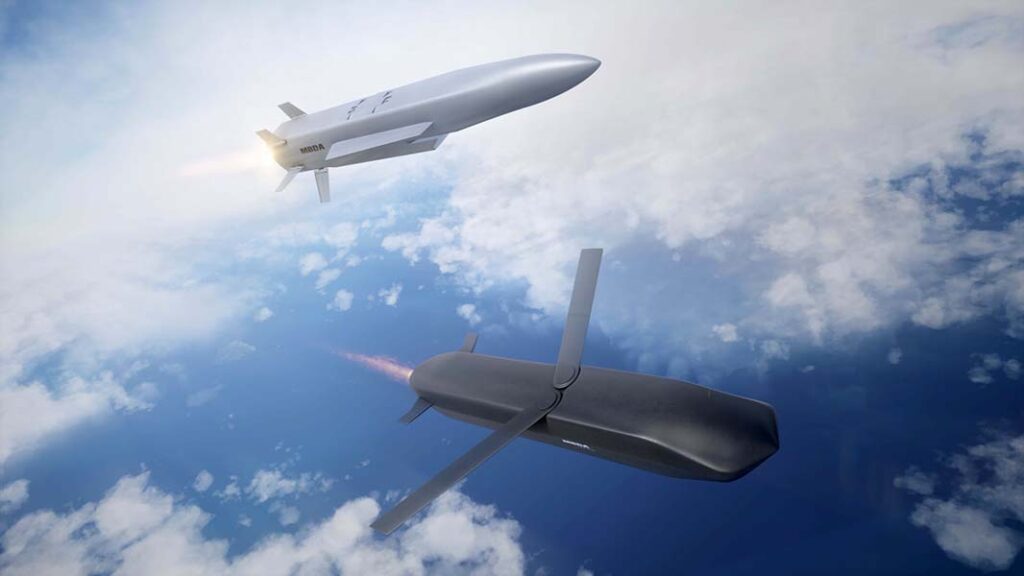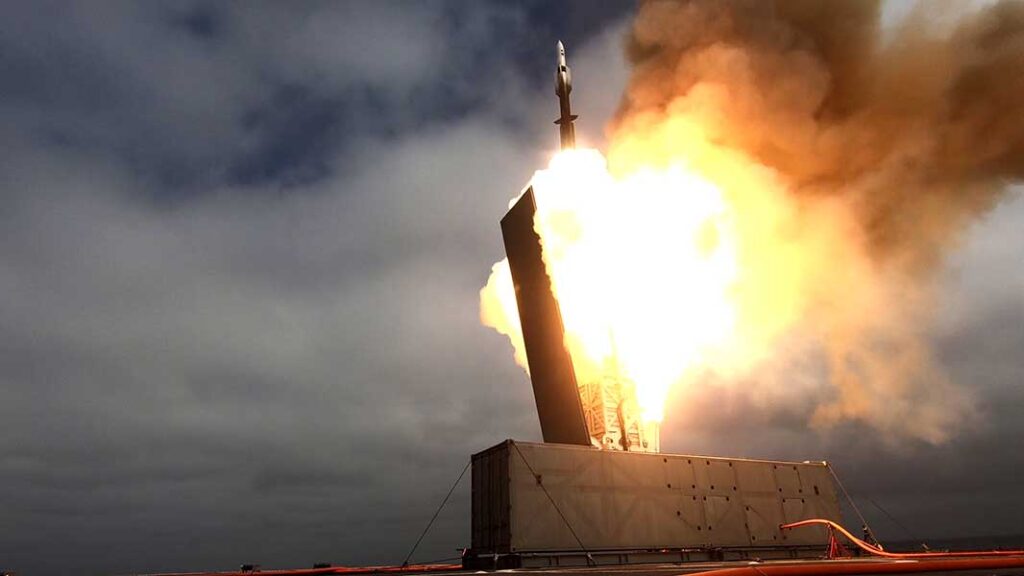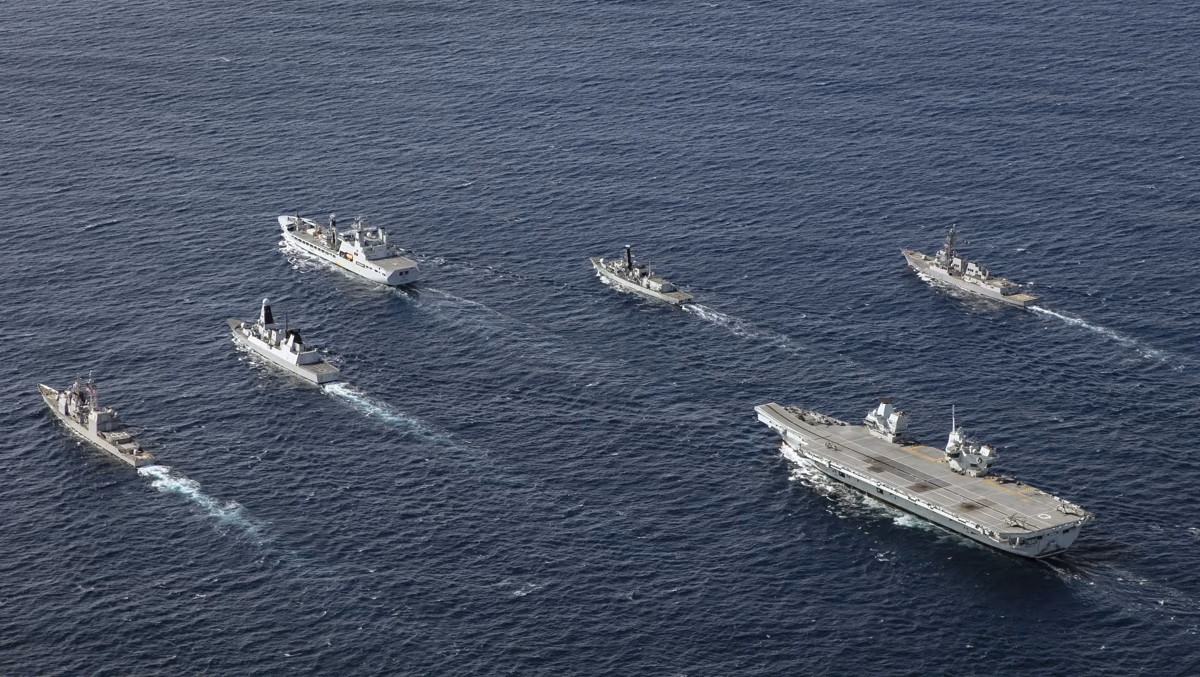Western militaries face an acute shortage of complex weapons while confronting numerically superior adversaries. Multifunctional interceptors offer an appealing solution – yet the reality of engineering missiles to excel in multiple roles proves more challenging than theory suggests.
The question of whether complex weapons should become more multifunctional is a subject of considerable discussion. In the US, the SM-6 missile, which can act as both a surface-to-air missile (SAM) as well as a land-attack and anti-ship capability, represents an exemplar of this design philosophy in action.(1) In Ukraine, the Russia’s ability to use SAM systems as a crude form of rocket artillery has also been demonstrated.(2) A focus on multifunctionality has also characterised the design of the Anglo-French Future Cruise/Anti-Ship Weapon (FC/ASW) which will apparently be capable of engaging naval vessels, land targets and high-value aerial targets.
At one level, this is understandable. Complex weapons pipelines are highly strained throughout the West, and the ability to get more functionality out of any given system represents a partial solution to this challenge. It is also the case that the capacity to integrate offence and defence represents a means of mitigating the challenge of adversary mass, which is an acute problem for Western forces and their Allied across multiple theatres. A number of sensors already support offence-defence integration, with examples including the AN/MPQ-64 radar which forms part of a Patriot battery.(3) The radar is capable of calculating the launch position of a target such as a tactical ballistic missile based on its trajectory. It would stand to reason, then, that multifunctional interceptors should complement the inherent versatility of many sensors.
While there is much to be said for this argument, there are significant design trade-offs which multifunctionality imposes on the design of a missile. These trade-offs do not mean that versatility loses all value, but they provide reasons for planners to think carefully about when and where they seek to integrate functions on a single missile and what the price they pay for doing so is.
Multifunctionality in the maritime domain
The maritime domain represents an area where there has been considerable progress in the fielding of dual-use interceptors, with the US Navy’s SM-6 representing a leader in the class. The SM-6 Block 1B can be employed against air breathing targets, ballistic missiles, surface vessels and ground targets.(4) During the Valiant Shield Exercise in June 2022, the SM-6 was employed in a ship sinking exercise (SINKEX) involving a decommissioned frigate.(5)
While this multifunctionality is impressive, it comes at a price. In a rather literal sense, the SM-6 is one of the most expensive SAMs on the planet with an estimated unit cost of USD 10 million based on the prices for missiles delivered in FY24.(6) In addition, there are fundamental design differences between SAMs and anti-ship missiles. The propulsion system for a SAM is typically a solid rocket motor, which enables the missile to close the distance with fast-moving targets rapidly. By contrast, cruise missiles are typically jet powered which provides them with greater manoeuvrability (albeit typically at lower speeds) and the ability to fly low to evade shipboard air defences. If employed in an anti-ship role, a missile like the SM-6 would likely have to fly on a high-altitude trajectory which would make it independently vulnerable to on board air defences on a well-defended vessel.
There is something to be said, however, for the potential use of a missile such as an SM-6 as part of a larger salvo involving anti-ship cruise missiles. A number of operational analyses conducted by China’s People’s Liberation Army (PLA) examining the conditions for the defeat of an Aegis-equipped destroyer such as the Arleigh Burke class suggest that the convergent use of a ballistic missile and a number of anti-ship cruise missiles might be sufficient to saturate the vessel’s onboard radar.(7) In principle, an SM-6 acting as a ballistic target could play a similar role. However, it is unclear whether or not a similar role could also be played by a purpose-designed ballistic missile such as China’s ship-launched YJ-21, arguably at a lower cost with greater effectiveness.(8) True, a ballistic missile requires certain enabling features on a vessel such as the capacity to cold-launch missiles, as well as large diameter vertical launch system (VLS). However, the dimensions of an SM-6 do not vary drastically from those of many short-range ballistic missiles (SRBMs) such as PRSM; indeed SM-6’s booster diameter is wider than PRsM’s diameter.
Second, the warheads on SAM systems are typically poorly-optimised for the defeat of larger vessels and this is true of the SM-6 which appears to employ a blast fragmentation warhead across different categories. Moreover, the warhead is necessarily light to provide the missile with the kinematics needed to engage airborne targets. As such, the functionality of SM-6 against larger vessels remains an open question, with some analyses suggesting it has limited utility against larger vessels (something which would seem to be validated by the fact that it was one of a number of missiles used against a single frigate type target in the Valiant Shield SINKEX).(9)
It should be noted, however, that warhead size is not the best predictor of a missile’s lethality against a surface vessel, with kinetic energy on impact typically correlating more closely with the number of missiles on target needed to mission kill or sink a vessel.(10) Even so, however, a blast fragmentation warhead represents a poor tool with which to inflict structural damage on a vessel.
Arguably, multifunctionality might be achieved with a different warhead type such as a hit-to-kill warhead which could be employed against both air-breathing and ballistic targets, as well as high-value surface vessels. A missile with sufficient kinetic energy could in theory achieve lethal effects against a large vessel with even a relatively small warhead. This having been said, much is likely to depend on factors such as whether a missile penetrated a vital part of a vessel. More importantly, however, a SAM used on a ballistic trajectory will provide considerably less range than a comparably-sized cruise missile.

This raises the question of how missiles such as the supersonic, ramjet-powered RJ10 being developed for FC/ASW would be intended to operate, since as a cruise missile, it uses air-breathing propulsion, and thus does not follow the same design principles as the SM-6. If the RJ10 model is used against high-value targets such as bombers, the missile may have to keep pace with potentially supersonic, albeit relatively large, targets. Its ramjet engine should in principle enable supersonic flight at relatively high altitudes – for example Russia’s P-800 Oniks anti-ship cruise missile (ASCM) has a flight ceiling of 14 km (roughly the service ceiling of a Tu-22M bomber).(11)
However, complexity arises when designing a payload for two very different tasks. If one equips a missile like RJ10 with a large unitary warhead, such as the 300 kg warhead of a P-800 Oniks, or the 453 kg warhead of LRASM, then it is less useful as SAM given the negative impact of a large warhead on manoeuvrability. A smaller blast fragmentation warhead like the roughly 64 kg of the SM-6 warhead would allow for better functionality as a SAM, but at a cost in terms of anti-surface warfare utility. It could be argued that since kinetic energy is the best predictor of anti-ship lethality, this is an acceptable trade-off. This is particularly true given that in the European theatre most Russian targets are likely to be small surface vessels (with size being the other predictor of how many missiles are needed to sink a ship). However, while justifiable, this choice would necessarily entail trade-offs.
Finally, in addition to the complex dynamics associated with missile design, the matter of command and control (C2) bears considering. If air warfare officers and surface warfare officers are employing the same capabilities, there will be a pull on shared resources. Principle warfare officers can mediate these trade-offs, but multifunctionality makes it more difficult for each group of officers to anticipate precisely which resources will be at their disposal.
The land operating environment
Arguably in the land environment there are stronger incentives to employ dual-use missiles. This stems from the fact that many plausible targets for dual-capable missiles, such as tactical ballistic missile launchers and multiple launch rocket systems (MLRSs) are not large robust targets such as ships and can be destroyed with relatively small payloads. Indeed, evidence from Israel suggests that kinetic hit-to-kill warheads can inflict considerable damage on many types of launchers.
While it might be argued that there are a number of launch systems in the land environment which can engage high-value targets, including assets supporting from the air, it must be noted that doctrinally defined tasks such as suppression of enemy air defences (SEAD) will absorb the majority of the strike capacity in both the land and air domains in a number of theatres, including Europe. The suppression of the enemy air and missile threat might, then, benefit from the presence of dual-capable missiles, which can be employed by air defenders without a requirement for support from other arms and echelons.(12)

The use of dual-capable interceptors in the land operating environment is not without its own imposed costs. For example, active radar seekers are unlikely to be of utility against ground targets unless they employ especially small wavelengths. Even then, it is likely that a second mode of inference such as infrared (IR) seekers would be required to cross-reference target types – adding cost and weight to a missile. Alternatively, cueing could be provided from offboard by air assets redirecting missiles towards targets. This would require a network architecture comparable to the US Navy’s Naval Integrated Fire Control-Counter Air (NIFC-CA), as well as a mechanism for moving data using low-latency bearers. Equally, however, counterbattery attacks do not need to be perfect to deter the use of a tactical ballistic missile (TBM), for example, as they need to be prompt and have a sufficient chance of damaging impact – something which dual-capable missiles could achieve. Moreover, the development of low-payload effectors which can strike soft skinned targets (as well as supporting air defence) could also enable other parts of a strike campaign.
Closing thoughts
While there are arguably advantages to the use of dual-capable effectors, their development and fielding is by no means simple. Particularly in the maritime domain, even limited multifunctionality arguably imposes cost in excess of the value generated. In the land environment, there is somewhat more purchase for dual-capable effectors, albeit with some latent system engineering problems remaining to be resolved.
Dr Sidharth Kaushal
(1) Thomas Newdick. SM-6 Missile Used To Strike Frigate During Massive Sinking Exercise In Pacific. The Warzone. https://www.twz.com/sm-6-missile-used-to-strike-frigate-during-massive-sinking-exercise-in-pacific
(2) Army Recognition. Russia Repurposes S-300 Surface-to-Air Missiles for Ground Attacks Against the City of Kharkiv. Army Recognition. 5 Jan 2024. https://armyrecognition.com/focus-analysis-conflicts/army/conflicts-in-the-world/russia-ukraine-war-2022/russia-repurposes-s-300-surface-to-air-missiles-for-ground-attacks-against-the-city-of-kharkiv
(3) Sidharth Kaushal, Eran Ortal, Ran Kochav. Integrating Offence and Defence: Lessons from the Israeli Experience. RUSI. 11 October 2023. https://www.rusi.org/explore-our-research/publications/commentary/integrating-offence-and-defence-lessons-israeli-experience
(4) Thomas Newdick. SM-6 Missile Used To Strike Frigate During Massive Sinking Exercise In Pacific. The Warzone. https://www.twz.com/sm-6-missile-used-to-strike-frigate-during-massive-sinking-exercise-in-pacific
(5) Ibid
(6) Office of the Undersecretary of Defence Comptroller/Chief Financial Officer. Programme Cost By Weapon System. US Department of Defence Fiscal Year 2024 Budget Request. (Washington: DoD,2024) p.5-17
(7) James Holmes, Toshi Yoshihara. Red Star Over the Pacific: China’s Rise and the Challenge to US Maritime Strategy. (Annapolis: Naval Institute Press, 2018) p.228-235
(8) Armyrecognition. YJ-21 Missile Underscores China’s Hypersonic Weaponry Leadership. https://armyrecognition.com/news/navy-news/2024/yj-21-missile-underscores-chinas-hypersonic-weaponry-leadership
(9) Thomas Newdick. SM-6 Missile Used To Strike Frigate During Massive Sinking Exercise In Pacific. The Warzone. https://www.twz.com/sm-6-missile-used-to-strike-frigate-during-massive-sinking-exercise-in-pacific
(10) Wayne Hughes and Robert Girrier. Fleet Tactics and Naval Operations. (Naval Institute Press, Annapolis, 2018)
(11) CSIS. P-800/Yakhont/Bastion. https://missilethreat.csis.org/missile/ss-n-26/
(12) Sidharth Kaushal, Archer Macy, Alexandra Stickings. The Future of NATO’s Air and Missile Defence. (London: RUSI, 2021).



